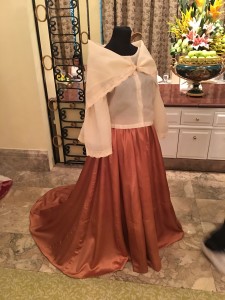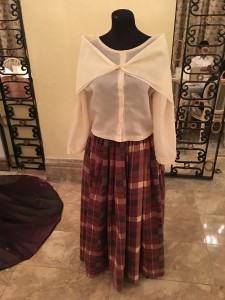
By Alex Y. Vergara
We know it today as the Maria Clara, the three-piece Filipino attire for women consisting of a loose skirt and diaphanous top usually made of cotton or piña with matching embroidered accessory known as the panuelo, but it was simply called baro’t saya by our ancestors during the Spanish colonial period.
No one exactly knows how it came to be known as the Maria Clara, but designer Jojie Lloren, quoting costume and production designer Gino Gonzales during a recent talk he gave to aspiring fashion designers, says that it’s just the dress’ “nickname” inspired most likely by one of the most famous characters in Jose Rizal’s Noli Me Tangere: the lovely but ill-fated Maria Clara.
Not to be confused with the terno, the other Filipiniana attire with iconic butterfly sleeves that became associated with former First Lady Imelda Marcos, the baro’t saya will be the inspiration behind Balik Saya, a fashion design competition hatched by Rep. Cristal Bagatsing of Manila’s fifth district in the hopes of updating, modernizing and perhaps making the Maria Clara more relevant to today’s generation of Filipino women.
Supported by Department of Tourism (DOT) Secretary Wanda Teo and National Museum Director Jeremy Barns, Balik Saya is tapping aspiring designers and seamstresses living or studying within Manila’s fifth district — which consists of Paco, Malate, Ermita, Intramuros, San Andres Bukid, Port Area and Baseco — to participate in the contest.
“Contestants should be residents of the fifth district, but it’s technically open to everybody, as long as they’re students of private and public schools located within the district,” says Cristal.
Finalists will be given three weeks to execute their respective designs. Apart from the mentoring to be provided by Jojie, each participant will be receiving P50,000 from DOT to fund their respective projects. The finished dresses will be worn by professional models in a fashion show on May 28 at the newly opened Museum of Natural History.
 “They’re free to hire sewers and patternmakers to help them execute their designs,” Cristal adds. “What we’re interested in are the finished products. To make sure they’re on the right path, Jojie would be monitoring their progress from time to time.”
“They’re free to hire sewers and patternmakers to help them execute their designs,” Cristal adds. “What we’re interested in are the finished products. To make sure they’re on the right path, Jojie would be monitoring their progress from time to time.”
From 40 entries, Jojie, assisted by fellow designers Ivar Aseron and Joey Samson, recently whittled the number down to 18 finalists. They based their choices purely on images drawn by contestants on paper. Since the objective is to reinvent and generate interest in the Maria Clara, conventional designs based on available images of the dress were out.
“No matter how beautifully drawn, if your design is the typical Maria Clara with embroidery and all, there’s nothing new or special about it. We don’t want a costume or pang customer type of Maria Clara,” says Jojie.
What organizers are looking for are new ways or approaches in executing and presenting the Maria Clara. Contestants need not even stick to its classic silhouette. But they’re required to adhere to certain guidelines. For instance, the finished design should be made of at least 25 percent indigenous fabrics like piña, jusi and inabel, among others. It should also be wearable and original.
“Once we picked the 18 finalists, we made them draw lots so that they would know the models they would be dressing up during the finals,” says Jojie.
Doing so was important, he adds. Apart from helping them get the women’s measurements right, knowing in advance who their models and their respective looks and personalities on the ramp were would give each participant an idea of what elements and details to play up or tone down in their designs.
As their mentor, Jojie’s main task is to edit and guide each participant’s work during the production process, including choosing the right materials to help them realize their designs. He will also advise them to either tone down certain elements or add more details depending on how their respective dresses are shaping up.
“That’s why it’s important for me to see their work in stages,” he said. “I won’t meddle in the design process. They’re free to reinvent the baro’t saya, but they have to be able to establish that the finish product is indeed a baro’t saya on finals night Therein lies the challenge.”
A panel of judges led by veteran designer Inno Sotto and composed of Barns, Tweetie de Leon-Gonzalez, Criselda Lontok, Teo and a representative from SoFA Design Institute will determine the top five contestants. Jojie, for his part, gets to pick the winner of a special award dubbed as “Jojie’s Choice.”
“He or she may or may not land in the top five,” Jojie explains, referring to his choice. “Since I worked with them during the production process, I could somehow pinpoint who among these aspirants have the potentials to go far as professionals.”
The five winning designers will bring home cash prizes (the first prize winner, for instance, would be getting P100,000), an apprenticeship at Rustan’s, an overnight stay at the Bayleaf in Intramuros and a workshop at SoFA Design Institute. A special award will also be given to the “Most Promising Ready-to-Wear Design.”
In a related development, Balik Saya will also hold an exhibit of ternos and baro’t saya at the Destileria Limtuaco Museum in Intramuros from May 17 to 26. On display will be vintage pieces from Patis Tesoro and Destileria Limtuaco, maker of such spirits as the Maria Clara sangria.
Cristal, citing the unique but ironic position her turf plays in the country’s bid to promote culture and tourism while generating jobs and eliminating poverty, sees the contest as the start of bigger things to come, as elected public officials like her bridge the widening gap between these two areas.
“Culture and the arts are centered here in my district, which includes Intramuros, Malate and Ermita,” she says. “There’s another side to these, which is poverty, admittedly in such areas as Baseco, Port Area and San Andres Bukid.”
Cristal hopes that activities like Balik Saya will be able to generate awareness for the entire fifth district and that such awareness would further translate into more businesses and jobs for people living in the area. Even those with good jobs and thriving businesses would benefit from such a scenario. How?
“If everyone has a stable job, his or her energies would be spent in positive and productive ways. Such an ideal scenario would eventually create and foster peace and order,” she says.






